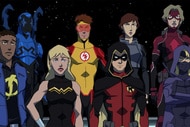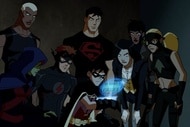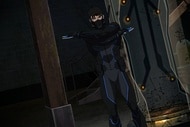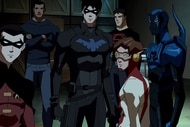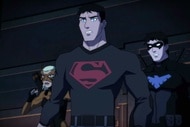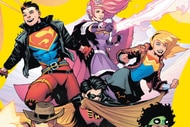'Young Justice' is still one of the best superhero shows ever because it's always changing
Young Justice looks very different in Season 4 than it did when it premiered 11 years ago today, but that's exactly why the series is so unique and so great.

Superhero fans are seeing, in real-time, the challenges of having a long-running live-action superhero universe. Bringing the Avengers together gets trickier when you have to deal with actors' schedules, salary demands, and the general ravages of time (and that's before we even talk about dueling studios who are tenuously sharing custody of a character.) It's a big part of why Captain America and Iron Man have, in various ways, made their exit from the MCU. A comic book superhero universe — or an animated one — doesn't really have this problem. There's nothing stopping a writer and artist from keeping a character around as long as they want.
Young Justice, which actually turns 11 on Nov. 26, is an animated superhero series, and as such it could have easily avoided this pitfall. Instead, it intentionally sidelined, wrote-off, elevated, or otherwise changed which characters it focused on — even characters that audiences probably assumed were going to be "main" characters. It's a willingly complicated way to create a superhero universe, and it's also the reason why Young Justice is one of the most unique — and best — superhero series we've ever seen, and it continues to be so in the ongoing fourth season now airing on HBO Max.
When Young Justice premiered back in 2010, it felt like any other superhero cartoon, something that was tonally and stylistically halfway between Justice League and Teen Titans. The show followed a group of DC sidekicks — Robin, Aqualad, Kid Flash, Speedy, Superboy, Miss Martian, and Artemis — as they became their own superhero team under Batman's guidance. Even as a larger, ongoing plot forms in the margins, there's an early expectation that these are our heroes and they'll go on a different adventure each episode. You know — standard cartoon superhero stuff.
But, as the season progresses, the world gets more complex. New characters like Zatanna and Rocket join the team, getting a lot of screen time and focus. The larger plot sees The Team get more and more involved in the evil organization known as The Light's plot. It all comes to a head towards the end of the season, when Speedy gets invited to join the Justice League — and reveals himself as a traitor. It's a pretty major shift of the status quo, made even more shocking because there isn't really a comics precedent for it. This isn't an adaptation of "The Judas Contract" where savvy viewers know Terra's a turncoat. This is something new and unexpected — and it's just the beginning.
Season 2 wildly changes things, however. Set five years after the events of the first season, Season 2 reveals that some of what we thought were "core" members of The Team are, in fact, out of the picture. Zatanna and Rocket have moved up to the Justice League, making them secondary characters who don't appear nearly as much. This is a bit of a shock because the back half of Season 1 spent a lot of time developing Zatanna's character while Rocket felt underdeveloped — like she just got there. In Season 2, both are sidelined. Kid Flash and Artemis have retired, Aqualad quit the team and turned evil (or so it would seem) and Robin has become Nightwing. New members join The Team, and the show makes it clear that it can (and will) focus or not focus on any one of them at any given time. To top it off, the season ended with the tragic death of one of the main heroes, Kid Flash, when he answered the call and came out of retirement.
Season 3 came around in 2019, when the now-defunct streaming service DC Universe brought back Young Justice for a revival. (It had been canceled in 2013 because toy sales were low.) Subtitled Outsiders, Season 3 further changed the dynamic of the team. Aqualad had become Aquaman and was in the Justice League rather than with The Team, there were new characters like Traci Thurston, Batgirl had become apparently become paralyzed between seasons and was now operating as Oracle, and there was a whole new superhero team, The Outsiders, whose roasted consisted of old and new faces. Much of the main plot of the season revolved around training new metahumans like Gabrielle "Violet Harper" Daou, the Markovs, and Forager.
Season 4, which airs on HBO Max, seems to be focusing on the original characters, but it has them spread out more. Despite being in the opening credits, characters like Aquaman and Zatanna have yet to make an appearance as of the publication of this article, and Superboy, Miss Martian, and Tigress (formerly Artemis, one of many name changes in the series) have had largely separate plots that play out over the course of several episodes. Also, our characters have grown up and some are getting married — or at least, that's the plan, until tragedy strikes.
There is no status quo in Young Justice. It's a series that puts a lot of faith in its audience's ability to figure out what's going on, especially when there are seismic shifts to the makeup of The Team that go unexplained or hardly remarked upon. This allows for Young Justice to grow, and to turn that potential weakness of a live-action series, the fact that you might not always be able to use all of your characters, into a strength. Because things are always changing and growing, Young Justice makes its superhero world seem much bigger than what we see on screen. If a character can just casually get promoted to another superhero team, we know that there is much more going on in this world. Young Justice's approach to storytelling also makes that very comic book idea of legacy — characters who inherit their predecessor's mantle or move on to a new role — seem vital. These characters can change their costumes and codenames because they're more than those costumes or codenames.
More than a decade later, Young Justice looks very different than it did when it premiered. But, jarring as some of those changes were over the past three seasons, they all make sense and serve a purpose. Young Justice feels unlike any other superhero universe because it's not afraid to change — and it changes not because it has to, but because it wants to.




